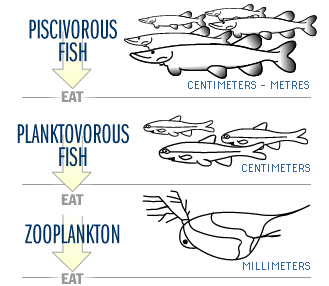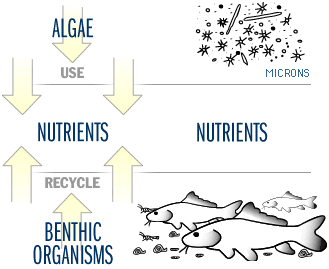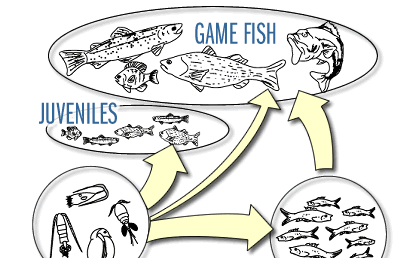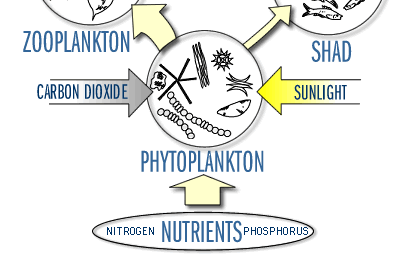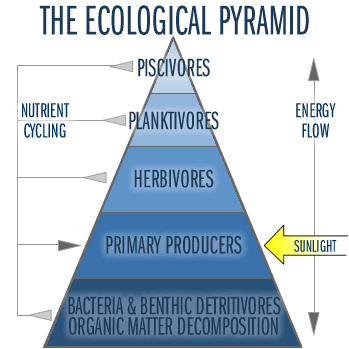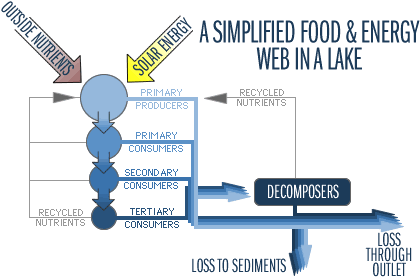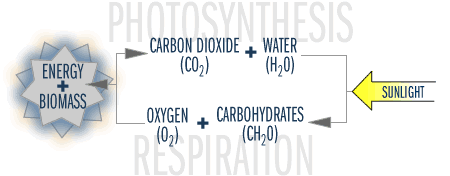 |
 |
![]()
The biological communities within lakes may be organized conceptually into food chains and food webs to help us understand how the ecosystem functions (Figures 12 and 13). The simplest illustration of the organization of the organisms within an ecosystem is the ecological pyramid (Figure 14). The broad base of primary producers supports overlying levels of herbivores (zooplankton), planktivores and much smaller numbers of carnivores (predators). These individual trophic levels may be idealized as a food chain, but in fact many organisms are omnivorous and not necessarily characterized by a particular level. Further, consumers in particular often shift levels throughout their life cycle. For example, a larval fish may initially eat fine particulate material that includes algae, bacteria and detritus. Then it may switch and graze on larger zooplankton and ultimately end up feeding on so called "forage fish" or even young game fish (i.e., top predators) when it reaches maturity (Figure 13).
TYPICAL FOOD CHAIN
Figure 12
FOOD WEB FOR LAKE MEAD, NV
Figure 13
Figure 14
Food webs may be described in terms of both energy and nutrient (carbon, nitrogen or phosphorus) flows (Figure 15). Although the process typically begins with sunlight-driven photosynthesis by algae and plants, balanced nutrition is also required to sustain life. For example, we cannot live strictly on sugar, despite its high caloric content, irrespective of what our kids may argue.
Figure 15
There are two basic life-sustaining processes in lakes, just as on land; photosynthesis and respiration. Green plants capture energy from sunlight to convert nonliving, inorganic chemicals (carbon dioxide, water, and mineral compounds) into living, organic plant tissue. Lake photosynthesizers include algae and macrophytes. Together, they are the primary producers, because they create the organic material required by most other organisms for nutrients and energy. Oxygen, the waste product of photosynthesis, adds to the oxygen supplied to the lake by the atmosphere. In water layers where photosynthetic rates are very high, such as during an algal bloom, the water may become supersaturated. That is, the oxygen content may exceed 100% of saturation with respect to the amount the water could hold if it was allowed to equilibrate with the atmosphere. This saturation value, in turn, depends on the temperature of the water. Colder water can hold more O2 than warmer water. During periods of stratification, the only potential source of O2 to the deeper zones of the lake is photosynthesis. This occurs only if light penetrates below the thermocline. In lakes where light does not penetrate below the thermocline, there is no internal source of oxygen to the deeper waters.
Figure 16
Besides light, algae and higher plants need oxygen, carbon dioxide (CO2), and mineral nutrients to survive and grow. Except for a very few species of blue green algae, most are unable to survive in anoxic (no O2) water. CO2 is virtually always available and comes from the weathering of carbonate rocks, such as limestone, in the watershed, diffusion from the atmosphere (very important in softwater, acid rain sensitive lakes), and from the respiration of organic matter by all of the organisms in the lake (see below). Dissolved mineral nutrients are absorbed from the water by algae and from the water and the sediments by higher plants. Typically, the most important nutrients are phosphorus and nitrogen, because they are present in very low concentrations unless there are sources of pollution ( see trophic state section) and are typically low enough to limit the growth of algae. Other minerals essential to life, such as the major ions (calcium, magnesium, sodium, and potassium) and certain trace metals (iron, cobalt, molybdenum, manganese, copper, boron, and zinc), are usually present at sufficient concentrations. Silicon is required by diatoms and a few other groups of algae and is usually, though not always, present at sufficient levels. Another mineral required by all living things, sulfur (in the form of sulfate), is typically not deficient in lakes.
The whole interaction of photosynthesis and respiration by plants, animals, and microorganisms represents the food web. Food webs are usually very complex and, in any one lake ecosystem, hundreds of different species can be involved. Because the available energy decreases at each trophic level, a large food base of primary producers (mostly plants) is necessary to support relatively few large fish.
These plants may die and decompose or be eaten by primary consumers – the second trophic level. This link in the food chain typically involves zooplankton grazing on algae but also includes larval fish eating zooplankton and a variety of invertebrates that eat attached algae (periphyton) and higher plants. Other animals, such as small fish, secondary consumers (third trophic level) eat the primary consumers and thus are considered secondary consumers. Still larger consumers such as large fish, ospreys, and people are tertiary consumers (fourth trophic level). Thus, energy and nutrients originating from the photosynthetic production of biomass and energy cascade through the food web (Figure 15). There is some recycling of nutrients back up to the top of the cascade. Respiration, the oxidation of organic material, releases the energy that was originally captured from sunlight by photosynthesis. Both plants and animals respire to sustain their lives, and in doing so, consume oxygen. Microorganisms (bacteria and fungi) consume a large fraction of available oxygen in the decomposition of excreted and dead organic material.
Decomposers are sinks for plant and animal wastes, but they also recycle nutrients for photosynthesis. The amount of dead material in a lake far exceeds the living material. Detritus is the organic fraction of the dead material, and can be in the form of small fragments of plants and animals or as dissolved organic material. In recent years, scientists have recognized that zooplankton grazing on detritus and its associated bacterial community represent an additional important trophic pathway in lakes.
